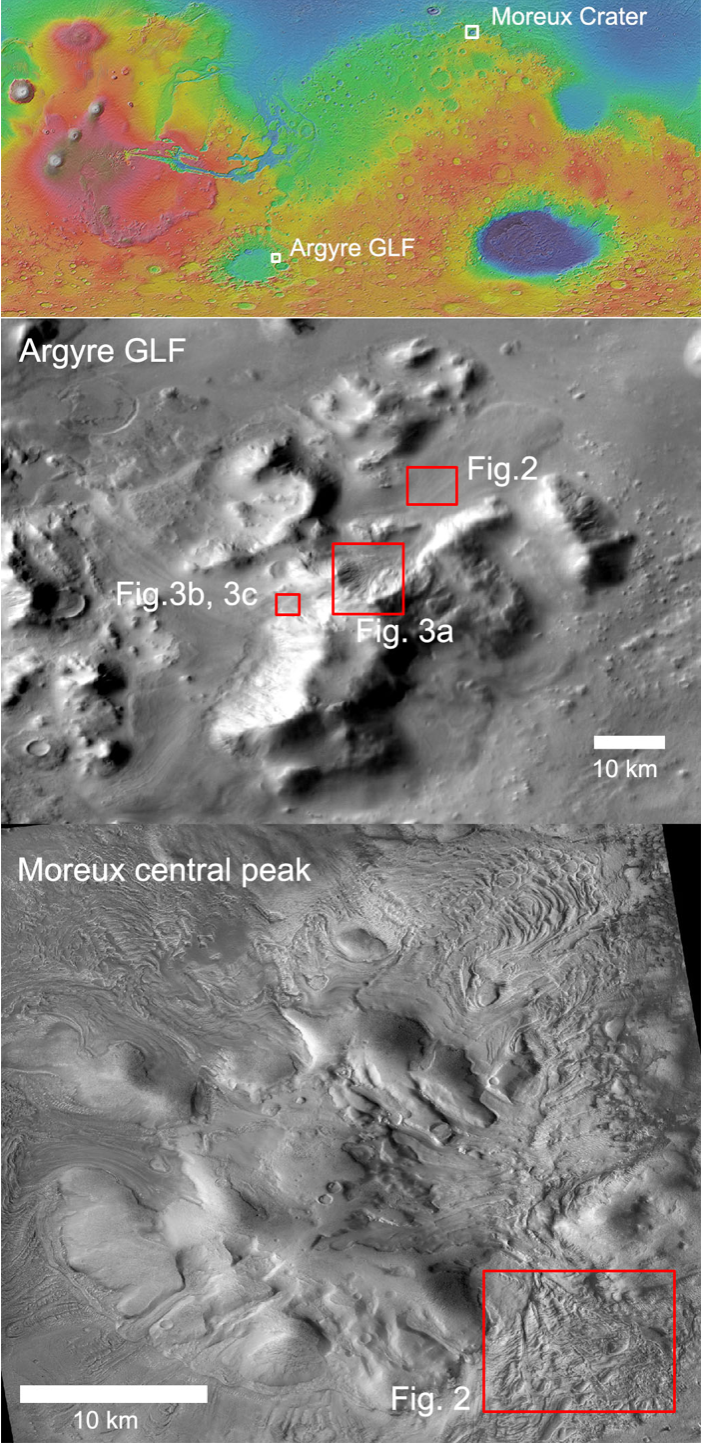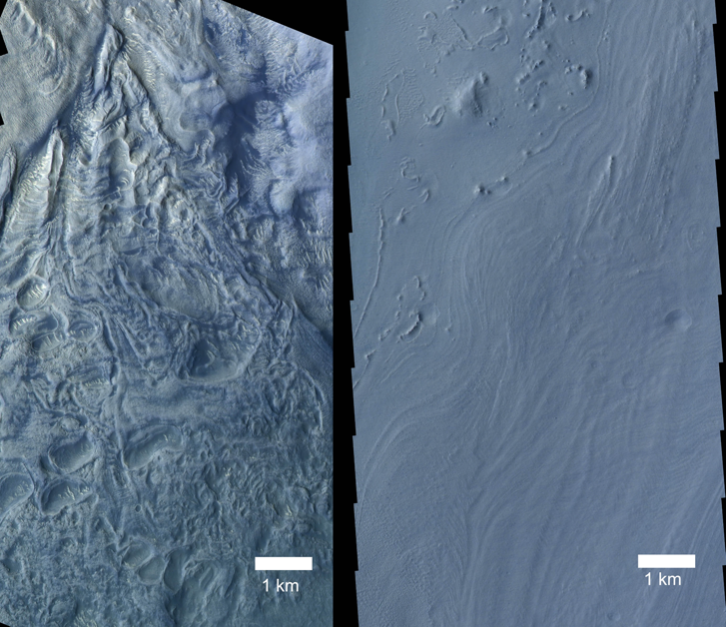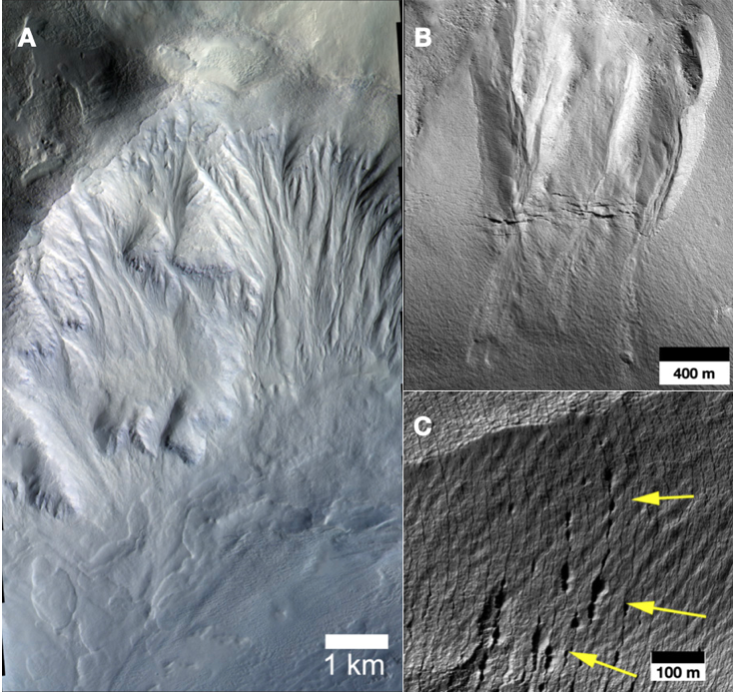The glacial landscape in Moreux crater versus a mountain glacier in Argyre, Mars: A comparative analysis
- Khalifa University, Space and Planetary Science Center and department of Earth Sciences, Abu Dhabi, United Arab Emirates (mohamed.elmaarry@ku.ac.ae)
Introduction: Glacier-like landforms (GLFs) and other classes of viscous flow features [e.g., 1-4] record the conditions when the obliquity of Mars allowed for the atmospheric deposition of ice in the mid-latitudes of Mars. However, they persist to this day because they are covered by a substantial dust that protects them from intense ablation. While substantial work has been carried out over the years to better understand and characterize GLFs, their geologic settings, morphometry, and overall morphology, we still need to better understand how GLFs evolve with time and what are the geologic or climatic controls on that evolution. Here, a preliminary comparative analysis is carried out between two notable GLF systems on opposite hemispheres: a notable mountain glacier system in eastern Argyre [5], and the central peak of Moreux crater that straddles the dichotomy boundary, and has received considerable attention given its inferred long-term glacial evolution, and potential polyphase glacial and periglacial features [e.g. 6-8]. Both systems are somewhat similar in terms of geologic setting (flows and features associated with a centralized high ground), overall scale, and apparently young age (100s of millions of years old), so a comparison of these two systems may yield new insights into how such systems evolve with time.

Fig 1. Top: a partly global map of Mars with superposed MOLA elevations showing the locations of the two study sites. Middle, and bottom: CTX view of the GLF in eastern Argyre and the central peak of Moreux’s Crater.
Moreux crater and its central peak: Moreux crater (41.8°N, 44.5°E) is ~133x135 km-wide complex crater, straddling the unconformity. Its northern-southern walls are more subdued and roughly the same height of the central peak, which is ~2 km high with respect to the crater floor. The central peak displays various glacial landforms and surface textures (Fig. 1). [7] indicate that the central peak has been substantially modified into an array of mounds and blocks that house coalesced flows, tributary Piedmont-like debris covered glaciers, LVF lobes, and draped flows. Furthermore, there is evidence for the development of more recent erosional features. In particular, polygonal patterns interpreted as seasonal thermal contraction cracks are observed in areas surrounding the central peak and the crater overall, as well as the areas around it [7,8]. The evidence for substantial erosion in addition to other features such as valley networks, esker-like ridges, and possible periglacial features in and around the crater suggest polyphase glacial and periglacial processes have affected the region [6-8].

Fig 2. CaSSIS false-color composite views of parts of the GLF systems in Moreux (left) and Argyre (right). Note the clear differences in surface texture and morphological diversity between both units.
Mountain glacier system in Argyre: The glacier system (47.5°S, 326.9°E) is located along the inner eastern rim of Argyre basin, It displays a wide mesa-like flat top more than 20 km across along its longest axis with steep (22–30°) sides that have developed into cirque-like alcoves [5]. The mountain displays 3 distinct lobes that appear to flow from the base of the cirques trending NE, NW, and SW, among other flows. Similarly to Moreux, the glacier system displays multi piedmont-like terminal lobes, gullies associated with cirque-like source regions, and evidence of periglacial modification of surface materials mainly in the form of polygonally patterned grounds [5]. Finally, the Argyre system is on average 2500 m higher than Moreux, which could have an important role in how both systems evolve.
Preliminary insights: The GLF system in Moreux appears to have been substantially ablated and there is a higher diversity and a wider extent of erosional features, most notably in Fig. 2 comparing two areas of equivalent setting and at the same scale using images from the Color and Stereo Surface Imagine System (CaSSIS) [9]. The Argyre system, which appears more pristine, lack evidence for wet-based glaciation. In particular, no substantial ablation is apparent, and there is no evidence of channels or eskers in close proximity to the GLF system there. However, Argyre’s GLF, displays evidence for more substantial gully activity (Fig. 3A), which has not been unambiguously identified at Moreux’s central peak [7]. If the gullies, are carved by liquid water, then it is not apparent why gullies would be active and abundant in Argyre, but not in Moreux, which would lend support to other mechanisms not involving liquid water activity [10]. Both GLFs display evidence for recent erosional modification, and possible as evident from the presence of patterned grounds. However, in Argyre’s case, there is additional evidence of further modification postdating gullies (Fig. 3B), and localized ablation occurring preferentially at the polygonal cracks perpendicular to the local slope (Fig. 3C). In summary, there is evidence for substantial morphological differences and varied evolutionary pathways for both GLF systems inspected, and it is worth investigating the reasons for this variety. It is expected that wet-based glaciation would lead to more intense landscape modification, but it is not clear why such conditions would have existed in Moreux but not in Eastern Argyre. Further analysis is envisioned and should hopefully yield more insights.

Fig 3. [A] CaSSIS false-color composite views of parts of the GLF system in Argyre showing extensive gully systems at the accumulation zone. [B] HiRISE view of the Argyre GLF showing gullies dissected by fractures. [C] HiRISE view of the Argyre GLF showing thermal contraction polygons showing progressive modification possibly caused by localized ablation along the fractured margins.
Acknowledgements: The authors acknowledge support from the internal grant 8474000336-KU-SPSC.
References: [1] Arfstrom, J., and Hartmann, W.K., (2005), Icarus, 174, 321–335. [2] Head. J.W. et al. (2010), EPSL, 294, 306–320. [3] Souness, C. et al. (2012). Icarus, 217, 243–255. [4] Hubbard, B. et al. (2014), Cryosphere, 8, 2047–2061. [5] El-Maarry M.R. and Diot, X. (2020), LPSC abstract #3070. [6] Marchant, D et al. (2006), LPSC abstract #1425. [7] Sinha R.K., and Murty S.V.S (2015), Icarus 245, 122-144. [8] Soare, R.J. et al. (2021). Icarus 362, 114401. [9] Thomas, N., et al. (2017), SSR 212, 1897-1944. [10] Dundas, C., et al. (2015), Icarus 251, 244-263.
How to cite: El-Maarry, M. R. and Harrington, E.: The glacial landscape in Moreux crater versus a mountain glacier in Argyre, Mars: A comparative analysis, Europlanet Science Congress 2022, Granada, Spain, 18–23 Sep 2022, EPSC2022-1033, https://doi.org/10.5194/epsc2022-1033, 2022.

